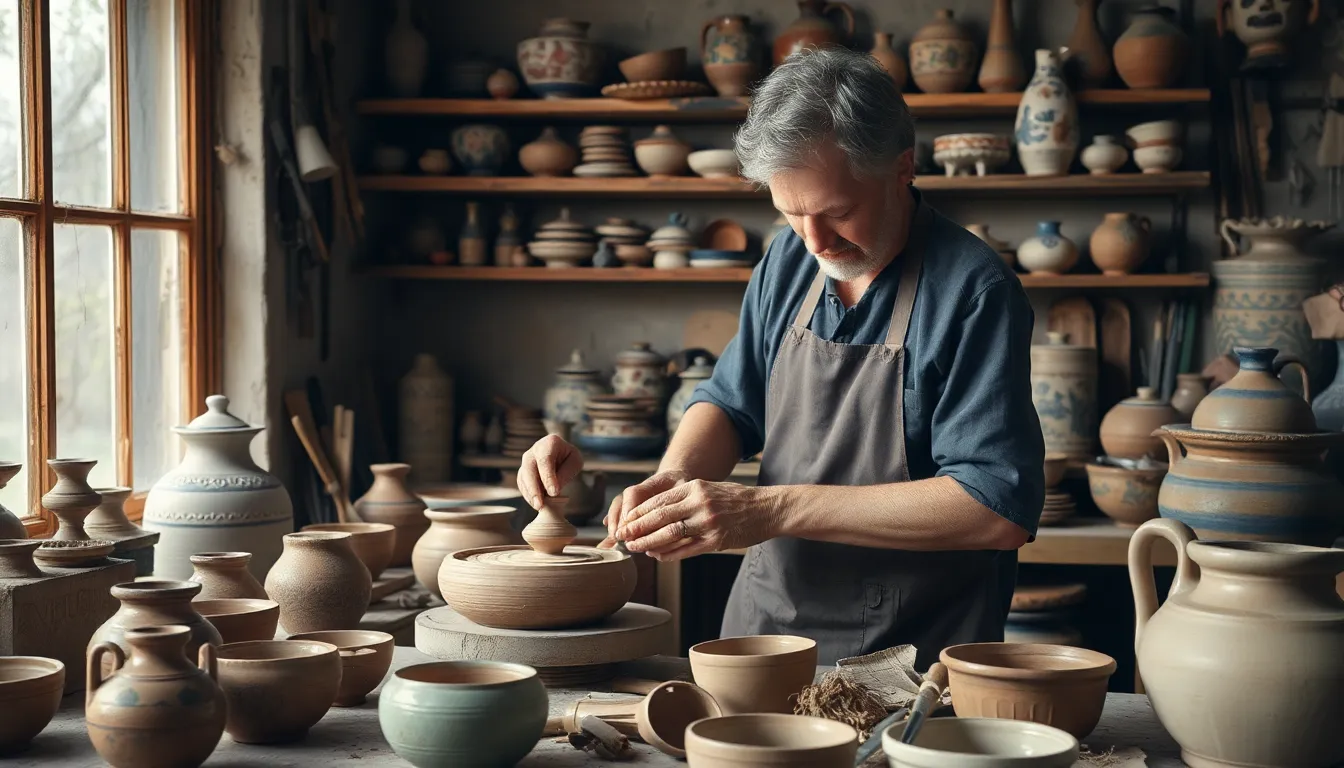Table of Contents
ToggleDesign isn’t just about aesthetics; it’s a time machine that whisks us through the ages, revealing the quirks and creativity of human culture. From the opulent tapestries of the Renaissance to the sleek lines of modern minimalism, decorative arts tell stories that textbooks often overlook. It’s like peeking into the lives of our ancestors and discovering their hopes, dreams, and occasional questionable fashion choices.
Overview of Decorative Arts
Decorative arts encompass various artistic disciplines, including ceramics, glassware, textiles, and furniture design. These forms of art serve both function and beauty, bridging the gap between aesthetics and usability. Historical periods such as the Arts and Crafts movement emphasized handcrafted quality, showcasing craftsmanship prominently. Distinct styles emerged across cultures, reflecting societal values and technological advancements.
In the Renaissance, intricate tapestries depicted allegorical narratives. This artistry not only adorned walls but also conveyed stories of power and identity. Asian influences introduced lacquerware and porcelain, praised for their elegance and fine detail. Modernism shifted perspectives, focusing on simplicity and minimalism, yet respecting materials’ natural qualities remained essential.
Functions of decorative arts extend beyond adornment. They contribute to cultural identity and social status, signifying wealth or taste. Analyzing decorative objects reveals insights into everyday life and prevailing trends of specific eras. Objects made from metal, glass, and fabric frequently reflect regional craftsmanship.
Throughout history, decorative arts transformed significantly, adapting to technological innovations. The Industrial Revolution marked a turning point, leading to mass production, which affected design accessibility. Art Deco and Mid-Century Modernism symbolize the evolution of style, embracing new materials and methods.
Contemporary decorative arts continue to thrive, merging traditional techniques with innovative approaches. Artists often challenge conventions, exploring sustainability and ethical practices. Thus, decorative arts serve as a vital avenue for understanding cultural narratives, revealing the interplay between art, design, and societal development.
Early Influences on Design

The foundations of design and decorative arts trace back to early civilizations. These influences shaped materials and techniques that still resonate in modern practices.
Ancient Civilizations
Ancient Egypt showcased remarkable craftsmanship through its pottery, jewelry, and furniture. Artisans employed local materials, creating functional yet decorative items. In Mesopotamia, vibrant ceramics reflected social structures and religious beliefs. The intricate patterns and motifs displayed a connection to cosmology and power. In Asia, dynasties like the Han and Tang emphasized fine silks and ceramics, reflecting cultural pride and technological advancements. Designs often symbolized prosperity, status, and spiritual significance, leaving a lasting impact on future artistic expressions.
Cultural Exchange and Trade
Cultural exchange significantly enriched design and decorative arts. The Silk Road emerged as a vital conduit for ideas and materials, linking East and West. Trade routes facilitated the flow of textiles, ceramics, and decorative motifs, igniting innovation. Techniques like pottery glazing traversed borders, enhancing aesthetics and functionality. The arrival of Chinese porcelain in Europe sparked a new fascination, prompting local artisans to experiment with similar styles. Additionally, the influence of Islamic art introduced geometric patterns and intricate designs, influencing various cultures and their artistic endeavors. Such exchanges fostered a dynamic dialogue between civilizations, reflecting diverse traditions and unifying them through art.
Development Through the Ages
Design dynamics evolved significantly through various historical periods, revealing cultural narratives and societal values. Each era brings unique contributions to decorative arts that continue to influence contemporary practices.
Renaissance and Baroque Periods
Renaissance art embraced realism, emphasizing anatomy and perspective. Artists crafted intricate tapestries and ornate furniture that showcased wealth and power. The Baroque period followed, characterized by excessive ornamentation and dramatic contrasts. Items like gilded mirrors and elaborate chandeliers adorned opulent interiors, reflecting grandiosity. Craftsmen often utilized rich materials, highlighting natural beauty and skill. Innovations in technique allowed for the development of new styles that influenced future generations. The thriving art scene during these times enriched not only aesthetics but also cultural identity.
The Industrial Revolution
The Industrial Revolution marked a turning point for decorative arts, introducing mass production methods. Factories began producing furniture and ceramics on a larger scale, making decorative items accessible to the middle class. This period witnessed the emergence of distinct styles such as Victorian and Arts and Crafts, emphasizing both function and beauty. Designers favored simplicity and craftsmanship in response to mass-produced goods. New materials like metal and glass were integrated into designs, allowing for innovative expressions. Overall, the Industrial Revolution transformed the landscape of art and design, influencing aesthetic values and practical applications.
Significant Movements in Decorative Arts
Decorative arts reflect historical movements that define cultural and aesthetic trends. These movements reveal how art, materials, and functionality interconnect over time.
Arts and Crafts Movement
The Arts and Crafts Movement emerged in the late 19th century as a reaction against industrialization. Focused on traditional craftsmanship, it prioritized quality materials and techniques over mass production. Influential figures like William Morris advocated for designs that integrated utility and beauty, emphasizing handcrafted items. This movement inspired a resurgence in textile design, ceramics, and furniture, influencing aesthetic values across Europe and North America. Its principles of simplicity and functionality continue to impact contemporary design, encouraging a return to artisanal practices.
Art Nouveau and Art Deco
Art Nouveau flourished from the late 19th century to the early 20th century, showcasing organic forms and intricate details. Designers such as Alphonse Mucha emphasized flowing lines and natural motifs, blurring the lines between decorative and fine arts. In contrast, Art Deco emerged in the 1920s, celebrating modernity and luxury. Characterized by geometric shapes and bold colors, this style incorporated new materials like plastics and metals. Both movements highlight the diversity within the decorative arts, tracking shifts in societal values and tastes during their respective eras. Their influence remains prevalent in today’s design landscape.
The Role of Material Culture
Material culture deeply influences how societies express identity and establish connections through everyday objects. Items from daily life often reflect cultural values and aspirations, carrying stories of their time.
Everyday Objects and Their Significance
Everyday objects serve as profound artifacts of cultural practices. Ceramics, textiles, and utensils provide insights into the daily lives of past societies. For example, a common ceramic vessel can reveal trade patterns, vibrant color choices reflecting regional influences. The social status of individuals often manifests in the style and quality of these items. Beyond functionality, decorative arts capture the aesthetic sensibilities and technological advancements of their time. Each object embodies the materiality of culture, shaping and reflecting daily experiences.
The Impact of Technology on Design
Technology dramatically alters design practices throughout history. Innovations in materials and production methods expand the possibilities for artists and designers. The introduction of mass production during the Industrial Revolution made decorative arts accessible to wider audiences, transforming consumer habits. For instance, the advent of synthetic dyes revolutionized textile design, introducing a spectrum of vibrant colors. Additionally, modern tools and techniques have led to new styles and expressions. Contemporary designers now blend traditional craftsmanship with digital technology, pushing the boundaries of what material culture can achieve.
Contemporary Trends in Decorative Arts
Contemporary decorative arts reflect a fusion of traditional practices and innovative approaches, showcasing the dynamic nature of design today.
Sustainability and Ethics in Design
Sustainability has become a cornerstone in contemporary design. Designers prioritize eco-friendly materials, experimenting with reclaimed wood and biodegradable plastics. Innovations in production methods also emphasize reduced waste, minimizing the environmental footprint. Ethical practices gain momentum as artists support fair trade and local artisans. Consumers increasingly seek products that align with their values, driving demand for transparency in sourcing. Additionally, design studios incorporate upcycling techniques, voicing commitment to responsible craftsmanship. These advancements contribute to a broader awareness of sustainability within decorative arts.
Globalization and Cultural Blending
Globalization significantly influences contemporary decorative arts. Cross-cultural exchanges enable designers to blend various traditions seamlessly. Techniques from different regions, such as Japanese and Scandinavian craftsmanship, now inform modern aesthetics. Artisans draw inspiration from diverse cultures, creating unique pieces that reflect a global narrative. Collaborations among international artists foster an explosion of creativity, resulting in hybrid styles. Moreover, accessibility through digital platforms allows for an exchange of ideas and techniques that were once limited to specific locales. This rich tapestry of influences highlights the interconnectedness of cultures in today’s decorative arts scene.
The journey through the history of decorative arts and material culture unveils a rich tapestry of human expression. Each era’s unique designs encapsulate the values and aspirations of their time while offering a lens into everyday life. As contemporary practices evolve, the integration of sustainability and cross-cultural influences continues to redefine the field.
This ongoing dialogue between tradition and innovation highlights the importance of decorative arts in shaping identities and fostering connections across the globe. Ultimately, the study of these arts not only enriches our understanding of history but also inspires future generations to appreciate the beauty and significance of design in their lives.







